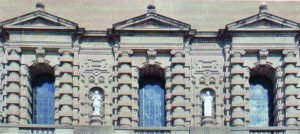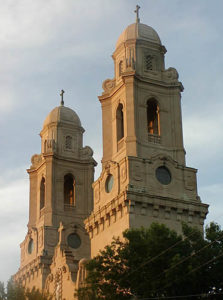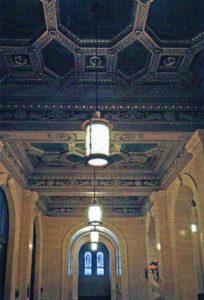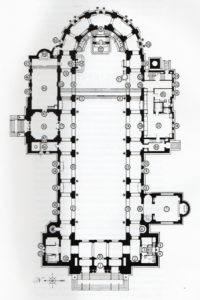Italian Renaissance characteristics of Saint Cecilia Cathedral
 Firstly, the architectural orders that define the overall framework for the facade, and indeed the entire body of the Cathedral, are in strict accordance with the classical canon invented in antiquity and that are a hallmark of the Italian Renaissance. Aside from the added touch of pairing the columns and pilasters as Kimball did to the Cathedral's entrance portals, narthex arcade, and Communion rail inside the church, (perhaps in Homage to the Renaissance invention of Michelangelo at Saint Peter's Basilica in Rom) the classical vocabulary is drawn direct from the text of The Five Orders of Architecture (Rome, 1562) by the Italian Renaissance architect Giacomo da Vignola.
Firstly, the architectural orders that define the overall framework for the facade, and indeed the entire body of the Cathedral, are in strict accordance with the classical canon invented in antiquity and that are a hallmark of the Italian Renaissance. Aside from the added touch of pairing the columns and pilasters as Kimball did to the Cathedral's entrance portals, narthex arcade, and Communion rail inside the church, (perhaps in Homage to the Renaissance invention of Michelangelo at Saint Peter's Basilica in Rom) the classical vocabulary is drawn direct from the text of The Five Orders of Architecture (Rome, 1562) by the Italian Renaissance architect Giacomo da Vignola.
 Secondly, another distinctly Italian Renaissance feature is the rusticated treatment of the Ionic Columns framing the windows on the second story of the Cathedral's facade and those surrounding the arched niche at the top. The shaft of these columns is banded with blocks to create "rustication" or a quarry-faced effect. Rustication is a common aspect of the later phase of the Italian Renaissance style known as Mannerism in which the elements of classical architecture were manipulated in a playful fashion. The Italian Mannerist style is subtle enough that only those well versed in the canon of classical design would even detect where rules have been broken. It seems that Kimball, perhaps in his own shot at Mannerist whimsy, attempted to do the same as Romano and other Italians centuries before him had done. The suggestion of a Mannerist flare seems to be at work by Kimball not just in the rustication of the window frames, but also through the telescope-like repetition of edges that seem to project outward from the surface in the end bays of the entrance facade and in the bell towers above it. Similarly the belt courses, architraves and entablatures that define the juncture points in the columnar bays and towers are out of sink with classical norms. They either break downward to reveal dentils, as at the center of the facade's end bays, or push upward breaking the line of the scrolled pediments, as occurs above the windows at the base of each tower. There is also the Mannerist sense in which the fenestration on the Cathedral's main facade seems to hover or float on the surface.
Secondly, another distinctly Italian Renaissance feature is the rusticated treatment of the Ionic Columns framing the windows on the second story of the Cathedral's facade and those surrounding the arched niche at the top. The shaft of these columns is banded with blocks to create "rustication" or a quarry-faced effect. Rustication is a common aspect of the later phase of the Italian Renaissance style known as Mannerism in which the elements of classical architecture were manipulated in a playful fashion. The Italian Mannerist style is subtle enough that only those well versed in the canon of classical design would even detect where rules have been broken. It seems that Kimball, perhaps in his own shot at Mannerist whimsy, attempted to do the same as Romano and other Italians centuries before him had done. The suggestion of a Mannerist flare seems to be at work by Kimball not just in the rustication of the window frames, but also through the telescope-like repetition of edges that seem to project outward from the surface in the end bays of the entrance facade and in the bell towers above it. Similarly the belt courses, architraves and entablatures that define the juncture points in the columnar bays and towers are out of sink with classical norms. They either break downward to reveal dentils, as at the center of the facade's end bays, or push upward breaking the line of the scrolled pediments, as occurs above the windows at the base of each tower. There is also the Mannerist sense in which the fenestration on the Cathedral's main facade seems to hover or float on the surface.
 Thirdly, Romano's contemporary and key arbiter of the Italian Renaissance tradition was the Venetian architect Andrea Palladio, who is acclaimed as the most influential and widely-imitated architect in history. One of the most recognizable and copied features associated with Palladio's architecture, or the so-called Palladian style, is the ubiquitous tripartite "Serliana," an arched opening symmetrically framed on either side by rectangular windows. The Serliana motif, largely popularized by Palladio but a decorative device that is properly coined after his Italian colleague Sebastiano Serlio, is repeated in several places within the Cathedral. On the exterior, the partial form of a Serliana is conceived in stone as balustraded windows halfway up the bell towers; while on the Cathedral's interior, the Palladian Serliana is carved from wood to define the overall silhouette of the confessionals; employed as an accent in the choir loft railing; and forms a continuous pattern surrounding the upper portion of the presbytery's framework.
Thirdly, Romano's contemporary and key arbiter of the Italian Renaissance tradition was the Venetian architect Andrea Palladio, who is acclaimed as the most influential and widely-imitated architect in history. One of the most recognizable and copied features associated with Palladio's architecture, or the so-called Palladian style, is the ubiquitous tripartite "Serliana," an arched opening symmetrically framed on either side by rectangular windows. The Serliana motif, largely popularized by Palladio but a decorative device that is properly coined after his Italian colleague Sebastiano Serlio, is repeated in several places within the Cathedral. On the exterior, the partial form of a Serliana is conceived in stone as balustraded windows halfway up the bell towers; while on the Cathedral's interior, the Palladian Serliana is carved from wood to define the overall silhouette of the confessionals; employed as an accent in the choir loft railing; and forms a continuous pattern surrounding the upper portion of the presbytery's framework.
 Serlio wrote a very influential treatise, The Five Books of Architecture. A print from Serlio's text illustrates the formula for the three-bay facade with a pair of bell towers not at all unlike the elevation of Saint Cecilia. Serlio's text and other architectural pattern books like it also featured antique Roman motifs of the Italian Renaissance classical revival including cherubs, masks, grape vines, acanthus leaves, lions, eagles, griffins, shields, urns, candelabra, grotesques, and the like. Many of these decorative elements are integral to the relief work of the Cathedral's interior including the carved wood sanctuary wall and the coffered plaster ceiling.
Serlio wrote a very influential treatise, The Five Books of Architecture. A print from Serlio's text illustrates the formula for the three-bay facade with a pair of bell towers not at all unlike the elevation of Saint Cecilia. Serlio's text and other architectural pattern books like it also featured antique Roman motifs of the Italian Renaissance classical revival including cherubs, masks, grape vines, acanthus leaves, lions, eagles, griffins, shields, urns, candelabra, grotesques, and the like. Many of these decorative elements are integral to the relief work of the Cathedral's interior including the carved wood sanctuary wall and the coffered plaster ceiling.
Beyond individual features and in a much broader sense, however, a specifically Palladian influence seems to have played a part in Kimballs' overall conception of the Cathedral's interior space. Harmonious proportional relationships were a key principle of Palladian, and indeed Renaissance architecture in the classical tradition. Palladio, in accordance with Renaissance theorists, believed it was possible to define Beauty itself, as "that reasoned harmony of all the parts within a body...the very same numbers that cause sounds...pleasing to the ears, can also fill the eyes and mind with wondrous delight." Beauty was thus equated with balanced dimensions that were mathematically related to one another, both at the level of the classical orders (column diameter to height, for example, as illustrated in the Vignolan canon), and on the all-encompassing scale of a building's overall dimensions of height, width, and breadth. Kimball seems to have applied these design principles, learned at the "Ecole, in creating what a scale ruler can measure on one of his renderings of the Cathedral, yet what only the sense can perceive as harmonious beauty if one stands inside the church.
 Kimball seems also to have paid homage to Palladio's ecclesiastic building in terms of the layout of the Cathedral's nave as can be seen by comparing a photographic view down the nave and a cross-sectional elevation with that of the Venetian church, Il Rendentore. In imitation of Roman-bath architecture, the clerestory along the upper nave has lunette-shaped thermal windows beneath which are round-arched side chapels linked together by entablatures that span both the Cathedral's and Il Redentores" circumference. The same interior configuration exists both at St. Peter's in the Vatican and at the Escorial, as this was common amongst sixteenth century basilical churches. Moreover, like the Italian-inspired design of El Escorial, the Cathedral has a like distinction between the plainness of the exterior in contrast to the opulence of the interior, that was effected through surface ornamentation and the rich application of color, gilding, and variety of materials.
Kimball seems also to have paid homage to Palladio's ecclesiastic building in terms of the layout of the Cathedral's nave as can be seen by comparing a photographic view down the nave and a cross-sectional elevation with that of the Venetian church, Il Rendentore. In imitation of Roman-bath architecture, the clerestory along the upper nave has lunette-shaped thermal windows beneath which are round-arched side chapels linked together by entablatures that span both the Cathedral's and Il Redentores" circumference. The same interior configuration exists both at St. Peter's in the Vatican and at the Escorial, as this was common amongst sixteenth century basilical churches. Moreover, like the Italian-inspired design of El Escorial, the Cathedral has a like distinction between the plainness of the exterior in contrast to the opulence of the interior, that was effected through surface ornamentation and the rich application of color, gilding, and variety of materials.
~The Beauty of Thy House, 2005
